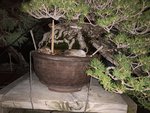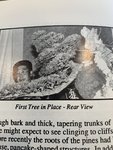You are using an out of date browser. It may not display this or other websites correctly.
You should upgrade or use an alternative browser.
You should upgrade or use an alternative browser.
Can you believe this is the same tree?
- Thread starter Adair M
- Start date
PaulH
Omono
Zuisho?
cmeg1
Imperial Masterpiece
Amazing material
Kokonoe. From a cutting. In 1989, it was over 30 years old. So, it’s over 60 now.Zuisho?
davetree
Omono
Love the bark. Will the hole in front ever close ?
Slowly. It was cut off maybe 25 years ago! Did you see the size of the “strong arm” branch?Love the bark. Will the hole in front ever close ?
davetree
Omono
Yes, big balls to cut that off, tip my hat to you.
GGB
Masterpiece
the long game
just.wing.it
Deadwood Head
Wow!
We get uglier as we age, for the most part.....but bonsai are quite the opposite!
Thanks for posting this one Adair
We get uglier as we age, for the most part.....but bonsai are quite the opposite!
Thanks for posting this one Adair
Beautiful tree. I am interested in your opinion concerning the densenes of the foliage between the two pictures. Is that solely personal preference or has bonsai evolved?Slowly. It was cut off maybe 25 years ago! Did you see the size of the “strong arm” branch?
MrWunderful
Omono
Damn definitely had a different “style” back then. I prefer todays!
TN_Jim
Omono
Rad! This may be an illusion but it looks like the foliage is slightly growing left to the sun.
Is this something?.
Is this something?.
AppleBonsai
Shohin
Who emasculated him?
I didn’t do it! I’ve only owned this tree a couple years. That branch was removed long, long ago.Yes, big balls to cut that off, tip my hat to you.
Here’s the story:
This tree and another Kokonoe, a Semi-Cascade were we’re sent to Southern California in 1988 by Yasou Mitsuya, along with a 125 lb Ibigawa Stone. The two trees were 30 plus years old, from cuttings, and Mitsuya and Tohru Suzuki, his apprentice, used them as a demonstration at the 1989 Golden State Bonsai Federation Convention. John Naka was the interpreter.
At the end of the demonstration, the composition was raffled off. A lady bought a single ticket, and for $5, she won it!
The trees were attached to the rock with wires, and the root balls were covered with muck. Mitsuya wasn’t happy with the muck, said it wasn’t sticky enough.
Anyway, the trees didn’t do well on the rock, and after a year, they were taken off the rock and potted as separate trees. Soon thereafter, the long branch was removed. Boon knows who did it, but I can’t remember.
The companion tree:

Sorry, it’s a bad picture! I’ll get a better one! It’s in a custom built Hagedorn pot.
So... these trees are now 60 plus years old.
As for the question about the needle quality... the trees are significantly older now, and old trees often lose the vigor of young trees. Then again, I have noticed that JWP does not fare as well in California as it does at my home in NEGeorgia. All the ones I have brought from California to my home have gotten significantly stronger. So, I suspect climate is involved.
I think it’s a cool tree, with a cool history. I’m proud to own it and be it’s current caretaker. The ladywho won it at auction owned it for 25 years, the Boon owned it for a couple years before he sold it to me, and now I’ve owned it a couple years.
The complete story of the original composition is documented in the Jan/Feb1990 Golden Statements bonsai magazine.
Are you talking about the black and white picture?Rad! This may be an illusion but it looks like the foliage is slightly growing left to the sun.
Is this something?.
Crazy Diamond
Omono
That style with the very long and prominent first branch were very popular in the old days in japan, its called Tatami-eda or something like that
Yes, they were often placed at the entrance to the garden, with the long branch pointing the way in, as an invitation to enter.That style with the very long and prominent first branch were very popular in the old days in japan, its called Tatami-eda or something like that
Yes, one reason I made this post is to show how long term care is important. So much of this forum is focused on creation of bonsai. Either from scratch, seed, cuttings, layers, or even collection of wild trees. Little attention is paid to the daily maintenance and long term care of established bonsai. And even once the tree is a bonsai, it can continue to grow and change.Wow!
We get uglier as we age, for the most part.....but bonsai are quite the opposite!
Thanks for posting this one Adair
Pitoon
Imperial Masterpiece
Slowly. It was cut off maybe 25 years ago! Did you see the size of the “strong arm” branch?
So if it has taken 25yrs to cover 1/3rd of the cut......50yrs more to cover it completely! Wow that's proof trees are in no rush.
Cosmos
Shohin
Adair, was flush-cutting the big branch a mistake in your view? Would it have healed quicker to do it in, say, 2 steps (like some do with JM), or to leave a big stub and reduce it over the years?
Similar threads
- Replies
- 2
- Views
- 417
- Replies
- 6
- Views
- 754
- Replies
- 50
- Views
- 6K
- Replies
- 8
- Views
- 990


